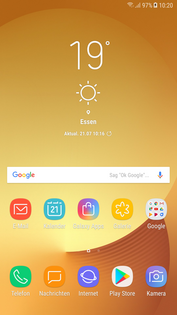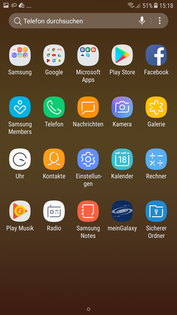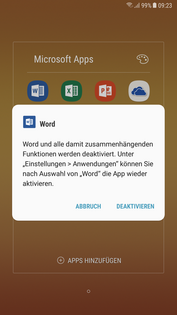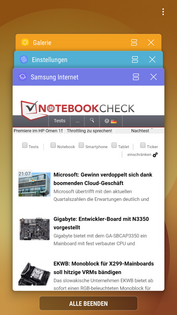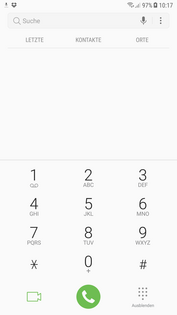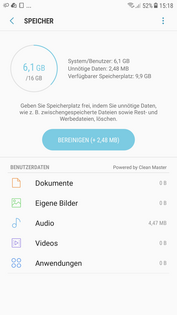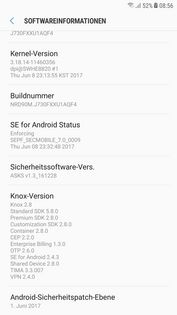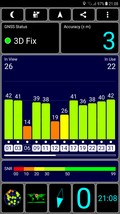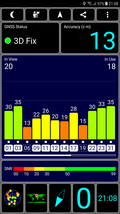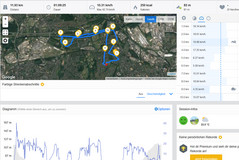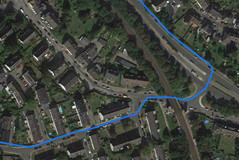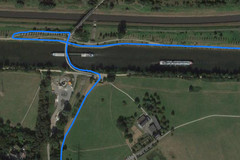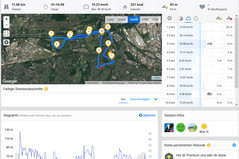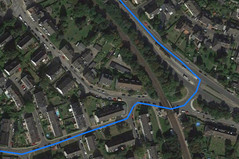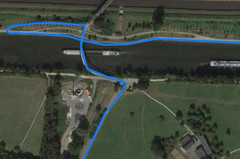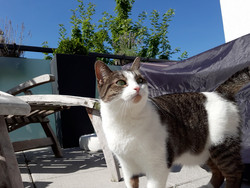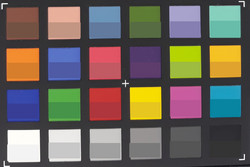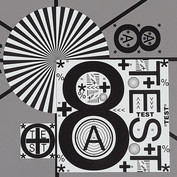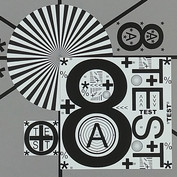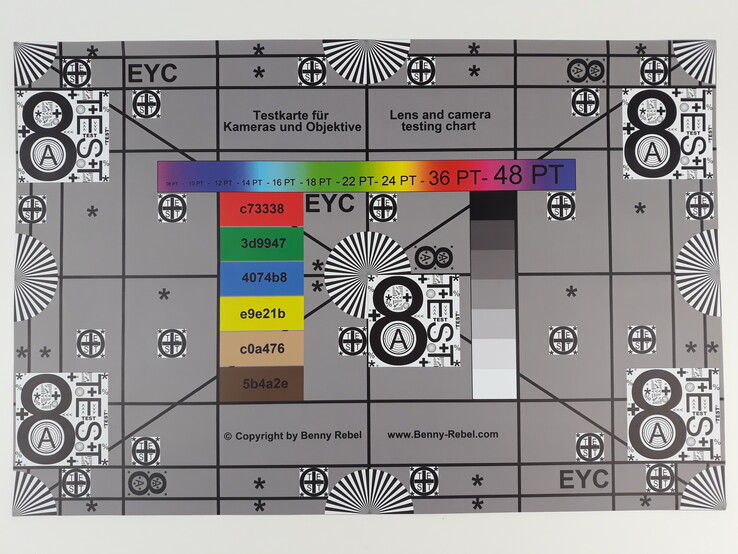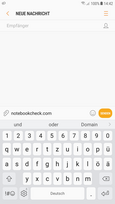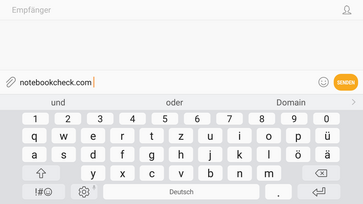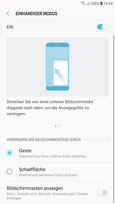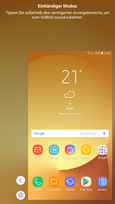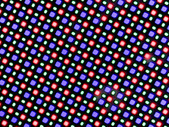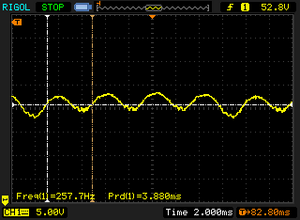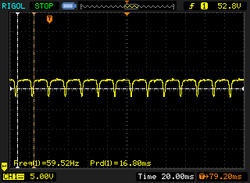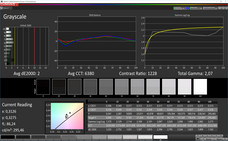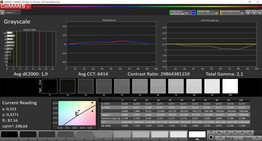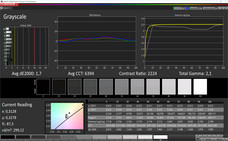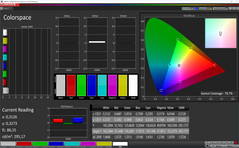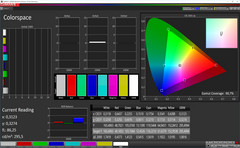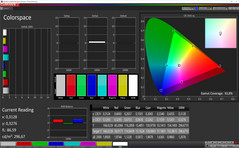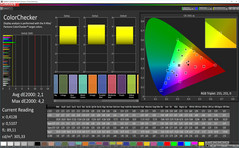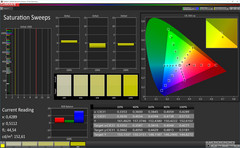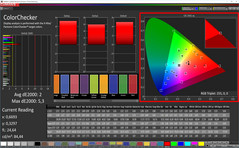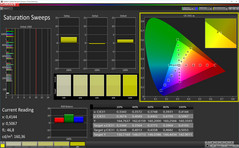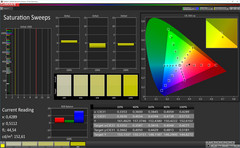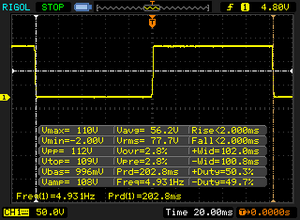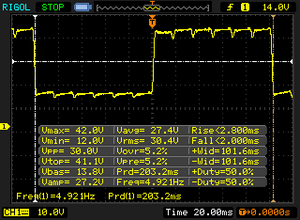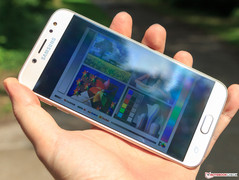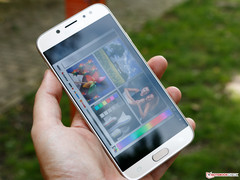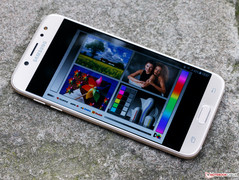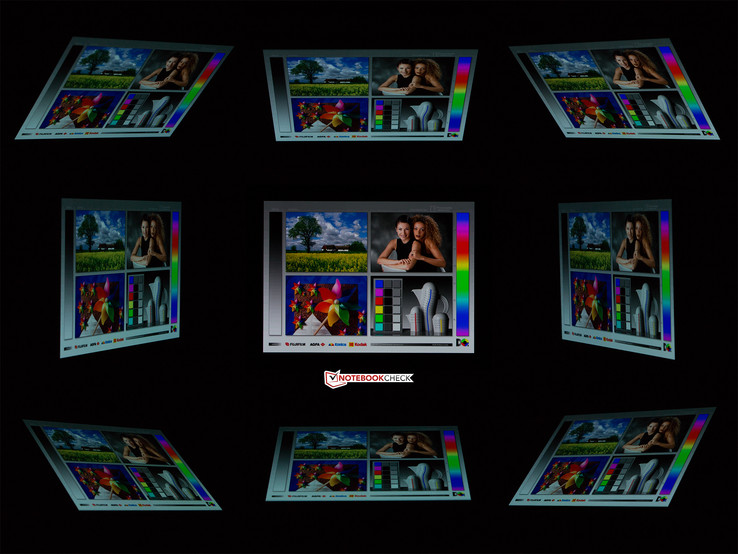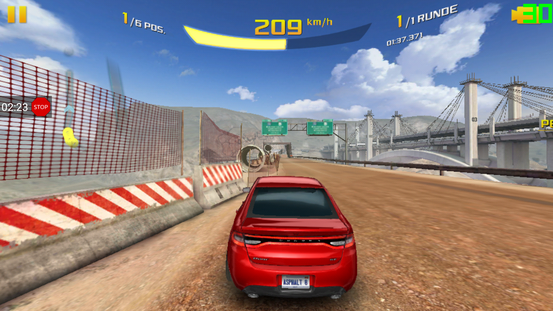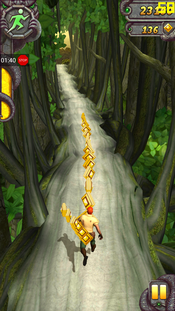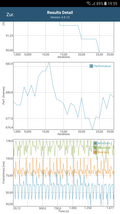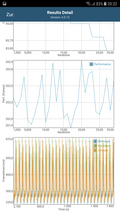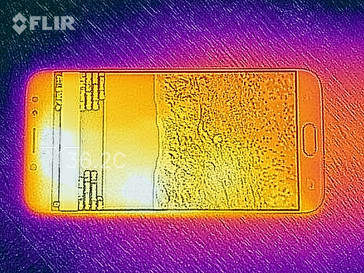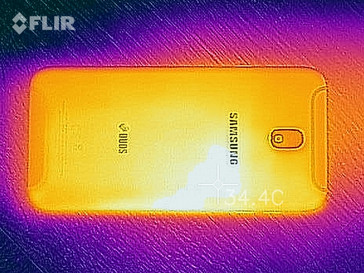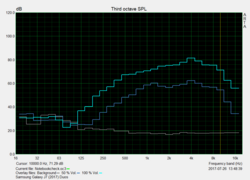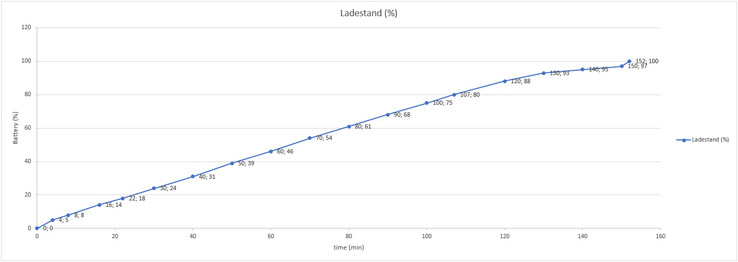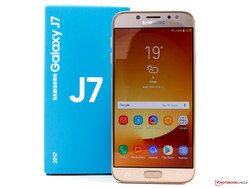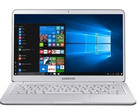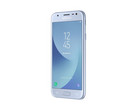Samsung Galaxy J7 (2017) Duos Smartphone Review
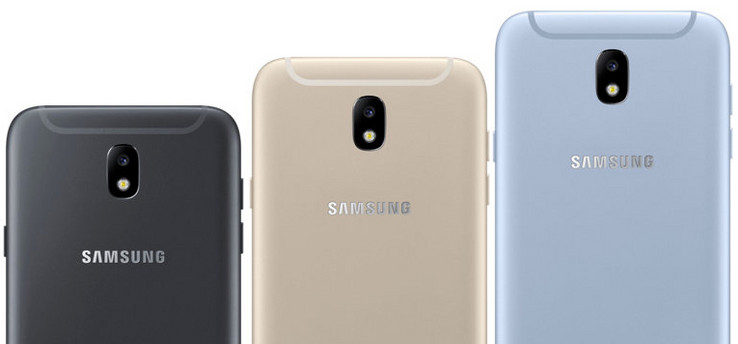
For the original German review, click here.
The model has entered the third round with the 2017 version of the Samsung Galaxy J7 (SM-J730F) Duos. It has had a full overhaul in the area of design. All smartphones of the Galaxy J series look almost identical with only the size differing among the various models.
It was slightly surprising to find that Samsung has chosen not to upgrade the processor and has stuck to the Exynos 7870 SoC, which was used in the 2016 version. The manufacturer has increased the device's working memory by 50% to a good 3 GB; internal storage remains unchanged at 16 GB. The communication modules have also been improved, and so have camera features. The J7 (2017) now has 3600 mAh (+ 300 mAh) and promises a significant increase in battery runtime. There was another surprise concerning the display: it now offers Full-HD resolution rather than simple HD.
We are testing the Duos version, which means that the Galaxy J7 (2017) has two fully-fledged Nano-SIM slots as well as a microSD slot. The device is available for about £340 (~$440).
We have chosen the Lenovo Moto Z Play, Asus Zenfone 3, Lenovo P2 and the Huawei Nova Plus as our comparison devices. They all have the same display size and are in the same price range.
Update 11/07/2017: Samsung has released a new firmware. Details can be found in the software section.
Case
Compared to last year's model, Samsung has done a complete design overhaul of the Galaxy J7 (2017) and has equipped the device with an aluminum unibody case. Unlike the J5, our test unit's dimensions have not increased drastically, despite it having a larger battery. We like the fact that the camera is slightly recessed into the case, which protects the glass from scratches. Samsung has given no information regarding the glass at the front of the device, but the transition to the aluminum is clearly visible. The gaps for antennas fit nicely to the whole design.
The Galaxy J7 seems very stable and does not warp even under high pressure. We noticed hardly any creaking. Transitions between materials are clearly visible, but nicely done with even and small gap dimensions. Unfortunately, the card trays and their covers are made entirely of plastic, which might lead to a change of color compared to the aluminum case after some time. The colors are identical at purchase.
The smaller card slot is meant for the first Nano-SIM, while the wider slot contains both the second Nano-SIM and the microSD card. While the Galaxy J7 (2016) still had a removable battery, it is fully integrated in the current generation and can only be exchanged by authorized professionals. The Galaxy J7 (2017) is available in black, gold and blue.
Connectivity
The bottom edge of the Samsung Galaxy J7 (2017) still has a Micro USB port, the manufacturer has not yet changed to the newer Type-C build for these entry-level phones. The port does not support video output, but it does support OTG, which means that peripheral devices can be connected as well as external storage devices. Unfortunately, the audio jack is also located on the bottom edge - we would have wished for it to be at the top.
Our test unit is a so-called Duos version. This means that the smartphone can use two Nano-SIM cards simultaneously. It is a fully-fledged dual SIM version, which allows additional use of a microSD card. The microSD slot supports the SDXC standard and therefore all usual storage mediums. Storage can be expanded up to 256 GB. It is not possible to format it as internal storage, but you can save larger apps on the optional microSD card.
The Galaxy J7 supports Bluetooth 4.1, Ant+, and Wi-Fi Direct and has both an NFC chip and an FM radio receiver.
Software
The Samsung Galaxy J7 (2017) is supplied with Google Android 7.0 Nougat combined with Samsung's own TouchWiz 8.1 interface. Apart from multitasking, the Game Launcher and Game Tools, it also offers other software features, which are described in detail in our review of the Galaxy J5. Apart from some Samsung apps and its own app-store, the device also comes with preinstalled apps from Microsoft and Facebook, which can only be deactivated, but not removed completely.
Android's security patches are up-to-date at the time of testing with the last update being from June 1st 2017.
Update 11/07/2017: Samsung has released firmware build NRD90M.J730FFXXU1AQI5 (396 MB). In addition to stability and bug fixes it is also supposed to contain new and enhanced features. However, we were unable to discover what exactly these were supposed to be. Google’s security patches have been updated to 08/01/2017.
Communication and GPS
The communication features are the same as in the smaller Galaxy J5 sibling. The Samsung Galaxy J7 (2017) connects via fast LTE Cat. 6 (max. 300 MBit/s download and 50 MBit/s Upload) on-the-move. The frequency range is also entirely sufficient within Europe. In addition, the phone supports Voice over LTE (VoLTE) and Wi-Fi telephony if this is also offered by the provider. The reception performance was normal in the cellular network of a city.
While we complained about the slow Wi-Fi module in the predecessor, Samsung has improved this. The Galaxy J7 (2017) supports the IEEE-802.11 standards a/b/g/n/ac now and uses the 2.4 and 5.0 GHz frequency bands. The Wi-Fi range is very good. The Wi-Fi signal was even strong in about 12 m distance to the router and through a wall and we could stream HD videos without problem. When connected to our Linksys EA8500 reference router, the transfer rates are also fast. The competitors in our comparison group cannot keep up with our test model in this respect.
| Networking | |
| iperf3 transmit AX12 | |
| Samsung Galaxy J7 2017 (Linksys EA8500, 5.0 GHz) | |
| Lenovo P2 (Linksys EA8500, 5.0 GHz) | |
| Lenovo Moto Z Play (Linksys EA8500, 5.0 GHz) | |
| Huawei Nova Plus (Linksys EA8500, 2.4 GHz) | |
| Asus Zenfone 3 ZE552KL (Linksys EA8500, 5.0 GHz) | |
| iperf3 receive AX12 | |
| Samsung Galaxy J7 2017 (Linksys EA8500, 5.0 GHz) | |
| Lenovo Moto Z Play (Linksys EA8500, 5.0 GHz) | |
| Lenovo P2 (Linksys EA8500, 5.0 GHz) | |
| Huawei Nova Plus (Linksys EA8500, 2.4 GHz) | |
| Asus Zenfone 3 ZE552KL (Linksys EA8500, 5.0 GHz) | |
Geolocation is done by means of the GPS, Glonass, and BeiDou satellite networks. The satellite fix is quite fast. At first, it is not particularly accurate however. It takes a while until it reaches a good accuracy of about 13 meters in buildings. It is done significantly faster and more accurate outdoor.
We checked the accuracy of the Galaxy J7's geolocation with a small bike ride and compared the performance to the Garmin Edge 500 bike computer. The total deviation of the about 12 km long route is just 30 meters - a very good result. A closer look at single segments reveals that the Garmin navigation system records the route slightly more accurate. However, you cannot complain about the minimal deviations of the smartphone.
Telephony and Call Quality
The design of the phone app ist simple and clear. Hence, everybody should be able to find his way around quickly. The tab places is a nice features and searches the area for amenities in order to directly show their contact data. This way, you can for example find the closest restaurant and book a table.
The call quality of the Samsung Galaxy J7 (2017) is not quite satisfactory; something which we have already criticized in the predecessor. Voices sound quite dull on both sides. In addition, the voice of the J7 user is occasionally interrupted by short dropouts. Ambient noise suppression is not available. The situation gets even worse with active speaker. Those who plan a longer phone call, should not use it. The included headset also does not use noise cancelling, but it performs quite well.
Cameras
The cameras are identical to those of the Galaxy J5 (2017). At the front of the Samsung Galaxy J7 (2017) there is a 13 MP camera with an LED flash. It has an aperture of f/1.9, which is supposed to support its low-light ambitions. Unfortunately, the camera only has fixed focus. The recordings are quite good under good light conditions as long as the subject does not move to quickly. In the dark, the LED flash can make images brighter.
The main camera on the back also has 13 MP with an aperture of f/1.7. Samsung has equipped the camera with a Sony IMX258 sensor with 1.12-µm pixels. This sensor is also present in the LG G6, for example. However, the relatively small pixels sized at 1.12 put this into perspective; even more so as the light sensitivity already reaches its maximum at ISO 1.250 (in manual mode ISO 800). LG has done a significantly better job in its flagship, but this belongs to an entirely different price category.
The shots of the Samsung Galaxy J7 are quite homogeneous in day light and deliver good results. In comparison to more expensive competitors, its dynamic range is quite limited. Thus bright parts could quickly get too bright. The smartphone compensates this by making the subject slightly darker, which shows in the comparison below. While the Galaxy collects much light and suppresses noise well under bad light conditions, contours and details get very blurry. As a result, shots already appear muddy at low magnification.
The J7 can record videos in Full HD (30 fps) at best. Due to the lack of image stabilization, the recordings blur quite easily and fast panning results in visible blurring.
We took a closer look at the main camera under controlled light conditions. The X-Rite ColorChecker Passport shows a good result. While many colors have a slightly higher saturation, they are definitely not over-saturated. The white balance is quite accurate. Skin color and blue colors are slightly too bright, light-orange is too faint.
The Galaxy J7 performs well in reproducing our test charts. At the center of the image all details are represented sharp and rich in detail. However, the sharpness falls relatively sharply towards the edges. Moreover, fonts slightly fray on dark backgrounds.
Accessories & Warranty
Samsung has given the Galaxy J7 (2017) a 24-month warranty, while the battery has twelve months and the accessories six. The warranty cannot be extended. Please see our Guarantees, Return policies and Warranties FAQ for country-specific information.
The smartphone comes together with a modular power supply with a nominal output of 7.75 watts (5 volts, 1.55 ampere), a USB cable, a headset as well as a small tool to open the card slots. You will also receive a short, printed QuickStart guide and a couple of leaflets regarding warranty, security information and regional restrictions.
Input Devices and Handling
The capacitive touchscreen of the Samsung Galaxy J7 (2017) does not perform worse than the Galaxy J5 in terms of gliding traits. It supports 10 instead of 5 point input however. Inputs are recognized quickly and reliably. Moreover, the display can be easily cleaned.
The fingerprint sensor sits in the home button and appears to be very good. It proved to be responsive and reliable and upon unlocking the user gets direct access to the system without pressing the button even if the smartphone is in standby. The two sensor buttons beside the home button also react reliably. However, unfortunately, they are not lit. One-hand mode is kept simple, yet effective. However, the thumb has to be slightly stretched in order to reach the opposite corner.
The variant known from the Galaxy S8 is used as default keyboard layout. It has a very clean design and also supports features such as swiping and automatic word suggestions. If you do not like it, you can install any layout from the Play Store.
Display
The Samsung Galaxy J7 (2017) has a 5.5-inch Super AMOLED display with a resolution of 1920x1080 pixels. This results in an increased pixel density of 401 PPI; content is therefore displayed with razor-sharp definition. It also finally has an ambient light sensor that can regulate screen brightness. The maximum brightness can only be reached when the sensor is activated. Otherwise, the Galaxy J7 (2017) reaches only 302 cd/m² in the center of the screen. If the sensor is allowed to do its work, it can increase the display's brightness to up to 454 cd/m² (at the same spot). During a measurement with evenly distributed light and dark surfaces (APL50), the brightness went up to almost 600 cd/m².
Because of the display's Super AMOLED technology, every single pixel is illuminated separately, which leads to a perfect black value. This, in theory, means good contrast that tends towards infinity. Clouding does not exist with this display technology. It has a blue light filter for the evenings, which is supposed to protect your eyes in the dark. The J7 also has an Always On display, which allows notifications, time and the calendar to be visible on the display even when this is turned off. The smaller J5 does not offer this feature.
| Samsung Galaxy J7 2017 Super AMOLED, 1920x1080, 5.5" | Samsung Galaxy J7 2016 Super AMOLED, 1280x720, 5.5" | Lenovo Moto Z Play AMOLED, 1920x1080, 5.5" | Asus Zenfone 3 ZE552KL IPS, 1920x1080, 5.5" | Lenovo P2 AMOLED, 1920x1080, 5.5" | Huawei Nova Plus IPS, 1920x1080, 5.5" | |
|---|---|---|---|---|---|---|
| Screen | -38% | -1% | -61% | -13% | -54% | |
| Brightness middle (cd/m²) | 454 | 287 -37% | 509 12% | 658 45% | 479 6% | 485 7% |
| Brightness (cd/m²) | 463 | 289 -38% | 511 10% | 633 37% | 477 3% | 481 4% |
| Brightness Distribution (%) | 86 | 91 6% | 93 8% | 93 8% | 91 6% | 90 5% |
| Black Level * (cd/m²) | 0.66 | 0.5 | ||||
| Colorchecker dE 2000 * | 2 | 2.9 -45% | 2.2 -10% | 4.9 -145% | 2.4 -20% | 4.2 -110% |
| Colorchecker dE 2000 max. * | 5.3 | 10.1 -91% | 5.8 -9% | 9.1 -72% | 5.6 -6% | 7.9 -49% |
| Greyscale dE 2000 * | 1.7 | 2.1 -24% | 2 -18% | 5.8 -241% | 2.8 -65% | 4.8 -182% |
| Gamma | 2.1 105% | 2.05 107% | 2.25 98% | 2.26 97% | 2.28 96% | 2.36 93% |
| CCT | 6394 102% | 6228 104% | 6768 96% | 7840 83% | 6702 97% | 7568 86% |
| Contrast (:1) | 997 | 970 |
* ... smaller is better
Screen Flickering / PWM (Pulse-Width Modulation)
| Screen flickering / PWM detected | 257.7 Hz | ||
The display backlight flickers at 257.7 Hz (worst case, e.g., utilizing PWM) . The frequency of 257.7 Hz is relatively high, so most users sensitive to PWM should not notice any flickering. However, there are reports that some users are still sensitive to PWM at 500 Hz and above, so be aware. In comparison: 53 % of all tested devices do not use PWM to dim the display. If PWM was detected, an average of 8086 (minimum: 5 - maximum: 343500) Hz was measured. | |||
As expected, the Super-AMOLED screen of the Samsung Galaxy J7 (2017) uses PWM for dimming the panel. Since the amplitude variation is very small, only very sensitive persons might feel its effects. A slightly higher frequency is first used from about 92 % brightness. Beyond that, the display even only works at 60 Hz, but shows longer lighting periods.
Samsung's Super AMOLED displays shine with intensive colors and crisp contrasts. This also conforms to our subjective impression of the Galaxy J7 (2017). Nevertheless, we have examined the panel more closely with the photo spectrometer and the CalMAN analysis software. We measured the manually selected color profiles. Each profile is optimized for a different color space. None of the color spaces is fully covered, albeit to a large extent. The white balance is exemplary in all profiles. Apart from a few exceptions, almost all color deviations remain below a DeltaE of 3. Hence, they are invisible to the naked eye.
Display Response Times
| ↔ Response Time Black to White | ||
|---|---|---|
| 4 ms ... rise ↗ and fall ↘ combined | ↗ 2 ms rise | |
| ↘ 2 ms fall | ||
| The screen shows very fast response rates in our tests and should be very well suited for fast-paced gaming. In comparison, all tested devices range from 0.1 (minimum) to 240 (maximum) ms. » 15 % of all devices are better. This means that the measured response time is better than the average of all tested devices (20.2 ms). | ||
| ↔ Response Time 50% Grey to 80% Grey | ||
| 4.8 ms ... rise ↗ and fall ↘ combined | ↗ 2.8 ms rise | |
| ↘ 2 ms fall | ||
| The screen shows very fast response rates in our tests and should be very well suited for fast-paced gaming. In comparison, all tested devices range from 0.165 (minimum) to 636 (maximum) ms. » 15 % of all devices are better. This means that the measured response time is better than the average of all tested devices (31.6 ms). | ||
Outdoor use profits from the OLED display's high maximum brightness and strong contrast ratio. Moreover, the J7 finally has an ambient light sensor, which reacts quickly to changing light and adjusts the brightness of the display accordingly. Thus, the smartphone even remains relatively well legible in direct sun. Reflections on the surface glass are disturbing however.
The viewing angle stability of the Super AMOLED panel in the Samsung Galaxy J7 (2017) is good. Color inversions can never be observed and brightness loss is even limited at very flat angles. The light color haze that is typical for AMOLED panels appears starting at about 30 degrees. It does not overly disturb, but it is already visible to the naked eye, when the smartphone lies next to you on the table.
Performance
The Samsung Galaxy J7 (2017) is equipped with the same processor as last year's model: the manufacturer's own Exynos 7870 SoC. This SoC is also present in other models such as the Galaxy J5 or the Galaxy A3. The chipset has a processor with eight Cortex-A53 cores that clock at up to 1.6 GHz and are manufactured in the 14 nm process. It has 3 GB of LPDDR2 RAM and 16 GB of internal storage. Graphics are taken care of by an ARM Mali-T830 MP1.
The CPU performance is similarly high as the Snapdragon 625's, which is used in most competitors. However, the GPU reaches its limits with the Full HD panel as shown by the graphics benchmarks. Depending on the benchmark, models from competitors perform between 80 and 164 better. The differences get most apparent when using the OpenGL-ES-3.0 API.
In regards of system performance, especially the Asus Zenfone 3 and the Moto Z Play deliver significantly better values. In everyday life, the Galaxy J7 delivers a good subjective performance however. This small weakness gets noticeable in short delays when switching between apps. In particular upday stutters.
| AnTuTu v6 - Total Score (sort by value) | |
| Samsung Galaxy J7 2017 | |
| Samsung Galaxy J7 2016 | |
| Samsung Galaxy J5 (2017) Duos | |
| Lenovo Moto Z Play | |
| Asus Zenfone 3 ZE552KL (6.2.1) | |
| Lenovo P2 | |
| Huawei Nova Plus | |
| PCMark for Android | |
| Work performance score (sort by value) | |
| Samsung Galaxy J7 2017 | |
| Samsung Galaxy J7 2016 | |
| Samsung Galaxy J5 (2017) Duos | |
| Lenovo Moto Z Play | |
| Asus Zenfone 3 ZE552KL | |
| Lenovo P2 | |
| Huawei Nova Plus | |
| Work 2.0 performance score (sort by value) | |
| Samsung Galaxy J7 2017 | |
| Samsung Galaxy J5 (2017) Duos | |
| Lenovo P2 | |
| Huawei Nova Plus | |
| Geekbench 4.4 | |
| 64 Bit Single-Core Score (sort by value) | |
| Samsung Galaxy J7 2017 | |
| Samsung Galaxy J5 (2017) Duos | |
| Huawei Nova Plus | |
| 64 Bit Multi-Core Score (sort by value) | |
| Samsung Galaxy J7 2017 | |
| Samsung Galaxy J5 (2017) Duos | |
| Huawei Nova Plus | |
| Compute RenderScript Score (sort by value) | |
| Samsung Galaxy J7 2017 | |
| Samsung Galaxy J5 (2017) Duos | |
| Huawei Nova Plus | |
| GFXBench 3.0 | |
| on screen Manhattan Onscreen OGL (sort by value) | |
| Samsung Galaxy J7 2017 | |
| Samsung Galaxy J7 2016 | |
| Samsung Galaxy J5 (2017) Duos | |
| Lenovo Moto Z Play | |
| Asus Zenfone 3 ZE552KL | |
| Lenovo P2 | |
| Huawei Nova Plus | |
| 1920x1080 1080p Manhattan Offscreen (sort by value) | |
| Samsung Galaxy J7 2017 | |
| Samsung Galaxy J7 2016 | |
| Samsung Galaxy J5 (2017) Duos | |
| Lenovo Moto Z Play | |
| Asus Zenfone 3 ZE552KL | |
| Lenovo P2 | |
| Huawei Nova Plus | |
| GFXBench 3.1 | |
| on screen Manhattan ES 3.1 Onscreen (sort by value) | |
| Samsung Galaxy J7 2017 | |
| Samsung Galaxy J7 2016 | |
| Samsung Galaxy J5 (2017) Duos | |
| Lenovo Moto Z Play | |
| Asus Zenfone 3 ZE552KL | |
| Lenovo P2 | |
| Huawei Nova Plus | |
| 1920x1080 Manhattan ES 3.1 Offscreen (sort by value) | |
| Samsung Galaxy J7 2017 | |
| Samsung Galaxy J7 2016 | |
| Samsung Galaxy J5 (2017) Duos | |
| Lenovo Moto Z Play | |
| Asus Zenfone 3 ZE552KL | |
| Lenovo P2 | |
| Huawei Nova Plus | |
| Lightmark - 1920x1080 1080p (sort by value) | |
| Asus Zenfone 3 ZE552KL | |
| Basemark X 1.1 | |
| Medium Quality (sort by value) | |
| Asus Zenfone 3 ZE552KL | |
| High Quality (sort by value) | |
| Asus Zenfone 3 ZE552KL | |
| Basemark ES 3.1 / Metal - offscreen Overall Score (sort by value) | |
| Asus Zenfone 3 ZE552KL | |
The Samsung Browser 5.4 is pre-installed for web surfing. Subjectively it works quite fast. Only more complex web sites occasionally need slightly longer to load.The Samsung Galaxy J7 (2017) performs slightly worse than the competitors in the comparison group and ranks at lower places in most cases. It is only faster in Mozilla Kraken 1.1.
| JetStream 1.1 - Total Score | |
| Lenovo Moto Z Play | |
| Huawei Nova Plus | |
| Asus Zenfone 3 ZE552KL | |
| Lenovo P2 | |
| Samsung Galaxy J5 (2017) Duos | |
| Samsung Galaxy J7 2017 | |
| Samsung Galaxy J7 2016 | |
| Octane V2 - Total Score | |
| Lenovo Moto Z Play | |
| Samsung Galaxy J5 (2017) Duos | |
| Asus Zenfone 3 ZE552KL | |
| Huawei Nova Plus | |
| Samsung Galaxy J7 2017 | |
| Lenovo P2 | |
| Samsung Galaxy J7 2016 | |
| Mozilla Kraken 1.1 - Total | |
| Samsung Galaxy J7 2016 | |
| Lenovo P2 | |
| Lenovo Moto Z Play | |
| Asus Zenfone 3 ZE552KL | |
| Huawei Nova Plus | |
| Samsung Galaxy J7 2017 | |
| Samsung Galaxy J5 (2017) Duos | |
| WebXPRT 2015 - Overall | |
| Asus Zenfone 3 ZE552KL | |
| Lenovo P2 | |
| Huawei Nova Plus | |
| Lenovo Moto Z Play | |
| Samsung Galaxy J5 (2017) Duos | |
| Samsung Galaxy J7 2017 | |
| Samsung Galaxy J7 2016 | |
* ... smaller is better
The Samsung Galaxy J7 (2017) features 16 GB internal eMMC flash memory. After the first start of the phone, 10 GB are free. The memory performance is decent, but the competitors are equipped with faster components.
The test model belongs to the first products of which we test the microSD card slot with our new Toshiba Exceria Pro M501 (UHS-II, class 3, writing: max. 270 MB/s, reading: max. 150 MB/s) reference card. The recorded values are relatively good, but they cannot not reach the potential of the mircoSD card by far.
| Samsung Galaxy J7 2017 | Samsung Galaxy J7 2016 | Samsung Galaxy J5 (2017) Duos | Lenovo Moto Z Play | Asus Zenfone 3 ZE552KL | Lenovo P2 | Huawei Nova Plus | |
|---|---|---|---|---|---|---|---|
| AndroBench 3-5 | -8% | -8% | 71% | 73% | 75% | 35% | |
| Sequential Read 256KB (MB/s) | 198.5 | 189.4 -5% | 204.4 3% | 254.8 28% | 282 42% | 270.1 36% | 241.6 22% |
| Sequential Write 256KB (MB/s) | 53 | 46.24 -13% | 52 -2% | 73.1 38% | 188 255% | 76.7 45% | 82.1 55% |
| Random Read 4KB (MB/s) | 25.86 | 22.33 -14% | 24.07 -7% | 38.78 50% | 74 186% | 38.2 48% | 35.64 38% |
| Random Write 4KB (MB/s) | 10.54 | 10.11 -4% | 9.9 -6% | 45.58 332% | 7.4 -30% | 44.4 321% | 30.12 186% |
| Sequential Read 256KB SDCard (MB/s) | 76.1 ? | 75.5 ? -1% | 72.2 ? -5% | 74.6 ? -2% | 79.2 ? 4% | 79.3 ? 4% | 41.64 ? -45% |
| Sequential Write 256KB SDCard (MB/s) | 63.9 ? | 58.2 ? -9% | 44.21 ? -31% | 50.6 ? -21% | 50.1 ? -22% | 59.4 ? -7% | 33.32 ? -48% |
Games
We could only recommend the Galaxy J5 for games to some extent. This is especially due to the weak ARM Mali-T830 MP1 GPU. The Samsung Galaxy J7 (2017) uses the same SoC, but it features 1 GB more RAM. However, this cannot compensate the extra performance required by the higher resolution Full HD panel. The Asphalt 8 race game can show this well. While the J5 reaches 22 fps with high details, the test model only achieves 18 fps. We recommend reducing the detail level in this game. Other performance-hungry titles such as Iron Blade (14 fps) are a real pain on the Galaxy J7 and cannot be enjoyed. Less demanding games such as Angry Birds 2 (51 fps) run without problems.
It is great that the Galaxy J7 also comes with software features such as the Game Tools or the Game Launcher now, which have first been introduced in the Galaxy S7. Thanks to the location of the speaker on a side, it can not be covered. You cannot complain about the sensors.
| Asphalt 8: Airborne | |||
| Settings | Value | ||
| high | 18 fps | ||
| very low | 30 fps | ||
| Temple Run 2 | |||
| Settings | Value | ||
| default | 59 fps | ||
| Dead Trigger 2 | |||
| Settings | Value | ||
| high | 30 fps | ||
Emissions
Temperature
The surface temperatures of the Samsung Galaxy J7 (2017) are comfortably low. The smartphone does not even get lukewarm under permanent load.
We checked the performance stability of the SoC with the battery test of GFXBench. The device shows constant performance in the lighter T-Rex test (OpenGL ES 2.0) as well as in the demanding Manhattan test (OpenGL ES 3.1). We could not detect throttling. However, the frame rates are significantly lower as in the Galaxy J5. This is caused by the higher resolution display of the J7.
(+) The maximum temperature on the upper side is 32.6 °C / 91 F, compared to the average of 35.2 °C / 95 F, ranging from 21.9 to 247 °C for the class Smartphone.
(+) The bottom heats up to a maximum of 31.5 °C / 89 F, compared to the average of 34 °C / 93 F
(+) In idle usage, the average temperature for the upper side is 30.7 °C / 87 F, compared to the device average of 32.9 °C / 91 F.
Speakers
The small mono speaker on the right edge of the Samsung Galaxy J7 (2017) is surprisingly loud and significantly better positioned as in the last-year's model, which had the speaker on the rear side. Hence, it is possible to place the smartphone on a table without affecting the sound now.
The size alone already limits the potential of the speaker. However, Samsung got still much out of it. While you should not expect wonders, the sound is quite ok for on-the-move. In particular mid-tones are well represented. However, high tones around 4 kHz are very present at maximum volume. As a result, for example, sibilants appear very hard and sharp to the listener.
Subjectively, the audio jack of the smartphone appears good and transmits sound cleanly and with low noise. The included headset is very present in the lower middles and higher bass range. As a result, sound appears slightly muffled.
Samsung Galaxy J7 2017 audio analysis
(+) | speakers can play relatively loud (87.1 dB)
Bass 100 - 315 Hz
(-) | nearly no bass - on average 26.6% lower than median
(±) | linearity of bass is average (10.9% delta to prev. frequency)
Mids 400 - 2000 Hz
(+) | balanced mids - only 3.2% away from median
(+) | mids are linear (4.3% delta to prev. frequency)
Highs 2 - 16 kHz
(±) | higher highs - on average 6.1% higher than median
(+) | highs are linear (4.4% delta to prev. frequency)
Overall 100 - 16.000 Hz
(±) | linearity of overall sound is average (20.3% difference to median)
Compared to same class
» 33% of all tested devices in this class were better, 9% similar, 57% worse
» The best had a delta of 11%, average was 35%, worst was 134%
Compared to all devices tested
» 52% of all tested devices were better, 8% similar, 40% worse
» The best had a delta of 4%, average was 24%, worst was 134%
Huawei Nova Plus audio analysis
(+) | speakers can play relatively loud (87.4 dB)
Bass 100 - 315 Hz
(-) | nearly no bass - on average 28.5% lower than median
(-) | bass is not linear (15.9% delta to prev. frequency)
Mids 400 - 2000 Hz
(+) | balanced mids - only 3.5% away from median
(+) | mids are linear (5% delta to prev. frequency)
Highs 2 - 16 kHz
(±) | higher highs - on average 5.7% higher than median
(+) | highs are linear (3.3% delta to prev. frequency)
Overall 100 - 16.000 Hz
(±) | linearity of overall sound is average (21.3% difference to median)
Compared to same class
» 41% of all tested devices in this class were better, 8% similar, 51% worse
» The best had a delta of 11%, average was 35%, worst was 134%
Compared to all devices tested
» 59% of all tested devices were better, 7% similar, 34% worse
» The best had a delta of 4%, average was 24%, worst was 134%
Asus Zenfone 3 ZE552KL audio analysis
(+) | speakers can play relatively loud (83.7 dB)
Bass 100 - 315 Hz
(-) | nearly no bass - on average 33% lower than median
(±) | linearity of bass is average (9.9% delta to prev. frequency)
Mids 400 - 2000 Hz
(+) | balanced mids - only 4% away from median
(+) | mids are linear (5.7% delta to prev. frequency)
Highs 2 - 16 kHz
(+) | balanced highs - only 2.8% away from median
(+) | highs are linear (6.1% delta to prev. frequency)
Overall 100 - 16.000 Hz
(±) | linearity of overall sound is average (21.7% difference to median)
Compared to same class
» 43% of all tested devices in this class were better, 8% similar, 49% worse
» The best had a delta of 11%, average was 35%, worst was 134%
Compared to all devices tested
» 61% of all tested devices were better, 7% similar, 32% worse
» The best had a delta of 4%, average was 24%, worst was 134%
Frequency diagram in comparison (checkboxes can be selected/de-selected!)
Energy Management
Power Consumption
The power consumption of the Samsung Galaxy J7 (2017) is extremely low. While running idle, the smartphone only exceeds the 1 Watt level by a small margin if all loads are active and the display is set to maximum brightness. However, the energy demand might be higher, wenn the ambient light sensor is active, since the display can get brighter in this case. If the sensor increases the brightness to the panel's maximum, the power consumption increases by 0.73 Watt, which is closer to the level of the competitors.
Unfortunately, the Galaxy J7 neither supports wireless charging nor fast charging. Hence, a full load needs above 2.5 hours.
| Off / Standby | |
| Idle | |
| Load |
|
Key:
min: | |
| Samsung Galaxy J7 2017 3600 mAh | Samsung Galaxy J7 2016 3300 mAh | Lenovo Moto Z Play 3510 mAh | Asus Zenfone 3 ZE552KL 3000 mAh | Lenovo P2 5100 mAh | Huawei Nova Plus 3340 mAh | |
|---|---|---|---|---|---|---|
| Power Consumption | -47% | -3% | -93% | -10% | -52% | |
| Idle Minimum * (Watt) | 0.39 | 0.67 -72% | 0.51 -31% | 0.83 -113% | 0.54 -38% | 0.49 -26% |
| Idle Average * (Watt) | 1.06 | 1.71 -61% | 0.87 18% | 2.11 -99% | 1.01 5% | 1.63 -54% |
| Idle Maximum * (Watt) | 1.08 | 1.83 -69% | 0.9 17% | 2.12 -96% | 1.03 5% | 1.76 -63% |
| Load Average * (Watt) | 1.82 | 2.37 -30% | 1.69 7% | 3.41 -87% | 1.78 2% | 2.98 -64% |
| Load Maximum * (Watt) | 3.21 | 3.31 -3% | 4 -25% | 5.46 -70% | 3.98 -24% | 4.99 -55% |
* ... smaller is better
Battery Life
With 3600 mAh, the battery of the Samsung Galaxy J7 (2017) is larger than the model's from 2016 by 300 mAh. Unfortunately, the test model cannot profit from this, but surprisingly delivers worse battery runtimes than its predecessor. In the comparison field, the J7 can also not take a top place, but ranks in mid range. Nevertheless, the battery runtimes are still very good as such. The Lenovo P2 offers a significantly longer battery life, but it is also equipped with a significantly more powerful battery.
The battery runtimes in our tests with adjusted display brightness (150 cd/m²) can be compared best. Only the P2 lasts longer when surfing the web via Wi-Fi. In our video loop, the Moto Z Play also proves to have more stamina. Various energy saving modes allow extended the battery life. These can also be found in the Galaxy J5.
| Samsung Galaxy J7 2017 3600 mAh | Samsung Galaxy J7 2016 3300 mAh | Lenovo Moto Z Play 3510 mAh | Asus Zenfone 3 ZE552KL 3000 mAh | Lenovo P2 5100 mAh | Huawei Nova Plus 3340 mAh | |
|---|---|---|---|---|---|---|
| Battery runtime | 15% | 13% | -21% | 16% | -17% | |
| Reader / Idle (h) | 32.5 | 33.8 4% | 42.3 30% | 25 -23% | 47.4 46% | 34.1 5% |
| H.264 (h) | 18.3 | 20.3 11% | 19.8 8% | 15.1 -17% | 20 9% | 12.2 -33% |
| WiFi v1.3 (h) | 15.1 | 17.1 13% | 13.7 -9% | 13.3 -12% | 16.3 8% | 13.7 -9% |
| Load (h) | 8.8 | 11.4 30% | 10.9 24% | 5.9 -33% | 8.8 0% | 6.1 -31% |
| PCMark for Android - Work 2.0 battery life | |
| Samsung Galaxy J5 (2017) Duos | |
| Samsung Galaxy A5 2017 | |
| Huawei Mate 9 | |
| Samsung Galaxy J7 2017 | |
| Sony Xperia XZ | |
| HTC U11 | |
Pros
Cons
Verdict
The Samsung Galaxy J7 (2017) is a well-made smartphone. However, it cannot dominate its competitors as much as the Galaxy J5. This gets especially apparent in terms of battery life. However, this is complaining on a high level, since they are still very good. Despite larger battery, they are unfortunately worse than last year's J7. Samsung might be able to improve this with an update.
The Samsung Galaxy J7 (2017) did not improve in all respects. Nevertheless, it is a great smartphone.
The Galaxy J7 (2017) can shine with its great Super-AMOLED display, which is finally controlled by an ambient light sensor - which was long overdue. Moreover, it features Full HD resolution now. Unfortunately, Samsung did not equip the phone with a slightly more powerful SoC in order to cope with the higher pixel density. This is noticeable in weak gaming performance, but might also be a reason for shorter battery runtimes. The cameras are not reference models, but they deliver good results if the environment is bright enough. The Wi-Fi module does not only support all current standards, but finally also delivers good transfer rates. The internal storage of 16 GB is also rather standard fare. However, the storage capacity can be expanded with a microSD without forgoing the dual SIM feature.
What remains is a visually improved smartphone. However, its battery is unremovable now. In return, it comes with a fingerprint sensor and 3 GB of RAM. It might be worth to buy last year's model for some.
Samsung Galaxy J7 2017
- 07/28/2017 v6 (old)
Daniel Schmidt


